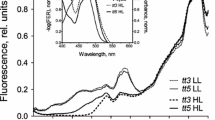Summary
Using the two-wavelength chlorophyll fluorometer the fluorescence induction kinetics (Kautsky effect) were measured simultaneously in the 690 nm and 730 nm region for ten common tree species during the greening period (April to July). The chlorophyll-fluorescence ratio F690/F730 (i.e. ratio of fluorescence intensity at the two maxima near 690 and 730 nm) was calculated from the laser-induced induction kinetics (He/Ne-laser 632.8 nm) at the fluorescence maximum and the steady state. The ratio F690/F730 decreases with increasing chlorophyll content of developing leaves. Its dependence on the chlorophyll content can be fairly well expressed by a power function which has a general validity for leaves, pigment extracts and chloroplast suspensions. The ratio F690/F730 is somewhat higher at maximum (fm) than at steady-state fluorescence (fs), but there is a very good correlation between both values. The ratio F690/F730 is a good indicator of the chlorophyll content and can be used as a non-destructive measure of the chlorophyll content of leaves. It also appears to be a suitable fluorescence parameter in the future remote sensing of the physiological state of the vegetation by laser-equipped airborne systems.
Similar content being viewed by others
References
Baker NR, Bradbury M (1981) Possible applications of chlorophyll fluorescence techniques for studying photosynthesis in vivo. In: Smith H (ed) Plants and the day light spectrum. Academic Press, London, pp 355–373
Briantais J-M, Vernotte C, Krause GH, Weis E (1986) Chlorophyll a fluorescence of higher plants: chloroplasts and leaves. In: Govindjee, Amesz J, Fork DC (eds) Light emission by plants and bacteria. Academic Press, Orlando, pp 540–577
Buschmann C (1981) Fluorescence induction kinetics of green and etiolated leaves by recording the complete in-vivo emission spectra. Photosynth Res 1:233–241
Haitz M, Lichtenthaler HK (1988) The measurement of Rfd-values as plant vitality indices with the portable field chlorophyll fluorometer and the PAM fluorometer. In: Lichtenthaler HK (ed) Applications of chlorophyll fluorescence. Kluwer, Dordrecht, pp 249–254
Krause GH, Weis E (1984) Chlorophyll fluorescence as a tool in plant physiology. II. Interpretation of fluorescence signals. Photosynth Res 5:139–157
Lichtenthaler HK (1987) Chlorophylls and carotenoids: pigments of photosynthetic biomembranes. Methods Enzymol 148:350–382
Lichtenthaler HK (1987) Chlorophyll fluorescence signatures of leaves during the autumnal chlorophyll breakdown. J Plant Physiol 131:101–110
Lichtenthaler HK (1988) Remote sensing of chlorophyll fluorescence in oceanography and in terrestrial vegetation: an introduction. In: Lichtenthaler HK (ed) Applications of chlorophyll fluorescence. Kluwer, Dordrecht, pp 287–297
Lichtenthaler HK, Buschmann C (1988) Changes in the chlorophyll fluorescence spectra during the Kautsky induction kinetics. In: Proc 4th Internat Coll Spetral Signatures of Objects in Remote Sensing, ESA, Noordwijk, pp 245–250
Lichtenthaler HK, Rinderle U (1988) The role of chlorophyll fluorescence in the detection of stress conditions in plants. CRC Crit Rev Anal Chem 19[Suppl]:S29-S85
Lichtenthaler HK, Rinderle U (1988) Chlorophyll fluorescence spectra of leaves as induced by blue light and red laser light. In: Proc 4th Internat Coll Spectral Signatures of Objects in Remote Sensing. ESA, Noordwijk, pp 251–254
Lichtenthaler HK, Buschmann C, Rinderle U, Schmuck G (1986) Application of chlorophyll fluorescence in ecophysiology. Radiat Environ Biophys 25:297–308
Papageorgiou G (1975) Chlorophyll fluorescence: An intrinsic probe of photosynthesis. In: Govindjee (ed) Bioenergetics of photosynthesis. Academic Press, New York, pp 319–371
Renger G, Schreiber U (1986) Practical applications of fluorometric methods to algae and higher plant research. In: Govindjee, Amesz J, Fork DC (eds) Light emission by plants and bacteria. Academic Press, Orlando, pp 587–615
Rinderle U, Lichtenthaler HK (1988) The chlorophyll fluorescence ratio F690/F735 as a possible stress indicator. In: Lichtenthaler HK (ed) Applications of chlorophyll fluorescence. Kluwer, Dordrecht, pp 189–196
Schreiber U (1977) Fluorescence induction in whole leaves: differentiation between the two leaf sides and adaptation to different light regimes. Planta 133:121–129
Sestak Z (ed) (1985) Photosynthesis during leaf development. Academia, Praha
Sestak Z, Siffel P (1988) Changes in chloroplast fluorescence during leaf development. In: Lichtenthaler HK (ed) Applications of chlorophyll fluorescence. Kluwer, Dordrecht, pp 85–91
Walker DA (1988) Some aspects of the relationship between chlorophyll a fluorescence and photosynthetic carbon assimilation. In: Lichtenthaler HK (ed) Applications of chlorophyll fluorescence. Kluwer, Dordrecht, pp 13–20
Author information
Authors and Affiliations
Rights and permissions
About this article
Cite this article
Hák, R., Lichtenthaler, H.K. & Rinderle, U. Decrease of the chlorophyll fluorescence ratio F690/F730 during greening and development of leaves. Radiat Environ Biophys 29, 329–336 (1990). https://doi.org/10.1007/BF01210413
Received:
Accepted:
Issue Date:
DOI: https://doi.org/10.1007/BF01210413



